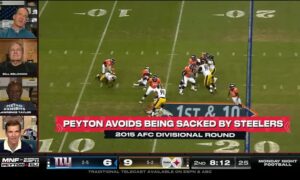By Matthew Marczi
End-of-season player exit meetings are not something that we are often privy to as outsiders of the football world. Generally, we only get a glimpse into that world when a player is asked by a reporter how the meeting went, if the player is willing to discuss it.
Still, it’s not generally a hard concept to grasp, and we have a pretty good feel by now of how Mike Tomlin and his staff likes to operate, and we see all the game film, so it’s not an overly difficult project to simulate. If we were to administer the end-of-season player exit meetings, it might go something like this.
Player: Emmanuel Sanders
Position: Wide Receiver
Experience: 4 Years
Emmanuel Sanders got the chance to be a full-time starter in 2013 when the entire wide receiver depth chart got reshuffled thanks to the departure of the head of the pyramid, Mike Wallace. Thus, Sanders move from the slot to the starting lineup, Antonio Brown became the top target, and Jerricho Cotchery took over the slot role after having very sporadic playing time in his first two seasons with the Steelers.
Did the team get the production out of their fourth-year receiver that they were expecting to get after being forced to match the one-year, $2.5 million offer sheet Sanders accepted from the New England Patriots? It’s a bit hard to say, but I would imagine it’s not the production Sanders himself hoped for.
For starters, while he came up with a career-high 740 receiving yards, that was still not even three-fourths of the way to a 1000-yard season that he said he expects out of himself when discussing 2013 during the offseason.
He also threw the 70-reception number out there, which he did come very close to, finishing with 67 catches on the year. The problem is that he averaged just 11 yards per catch. In comparison, Brown averaged 13.6 yards per catch and finished the season with more than twice Sanders’ yardage total on 110 receptions.
How to begin explaining the unimpressive yards per catch total? To start with, 17 of Sanders’ 67 receptions came behind the line of scrimmage, while another 34 came within the 0-9-yard range, so 51 of Sanders’ 67 catches came off passes aimed no deeper than nine yards down the field. Combine that with the fact that he had just six catches on passes aimed 20 or more yards down the field and we begin to paint a picture of not only how Sanders was used, but where he was successful.
In fact, Sanders was targeted on 23 passes 20 or more yards down the field, with by far his best success coming between the numbers, where he caught four of six targets. While he had only one drop on deep passes, the fact that a full 14 of 23 passes were uncatchable balls suggests that Sanders had trouble gaining separation from defenders on deep targets.
On the positive side, his six touchdowns is a reasonable total for a second receiver—Cotchery’s 10 touchdowns is obviously a significant outlier. Sanders’ mere 62 percent completion rate isn’t very pretty, but when you consider that his completion rate on passes within 19 yards was just under 72 percent, it paints a more accurate portrait.
Determining what Sanders is worth after this season is difficult, because his $2.5 million contract was in large part based on speculation of what he would do as a starter. By no means did he have a spectacular season, but did he show more than $2.5 million a season’s worth of play?
Could the Steelers afford to pay Sanders more than that per season, relative to the expected return on investment? Is that a luxury they can’t afford not to have, considering the only other current alternatives are Cotchery and Markus Wheaton? I’m sure the coaching staff is more interested in retaining him than is the front office.
Previous Articles In This Series
Steelers End Of Season Player Exit Meetings – QB Ben Roethlisberger
Steelers End Of Season Player Exit Meetings – WR Antonio Brown







